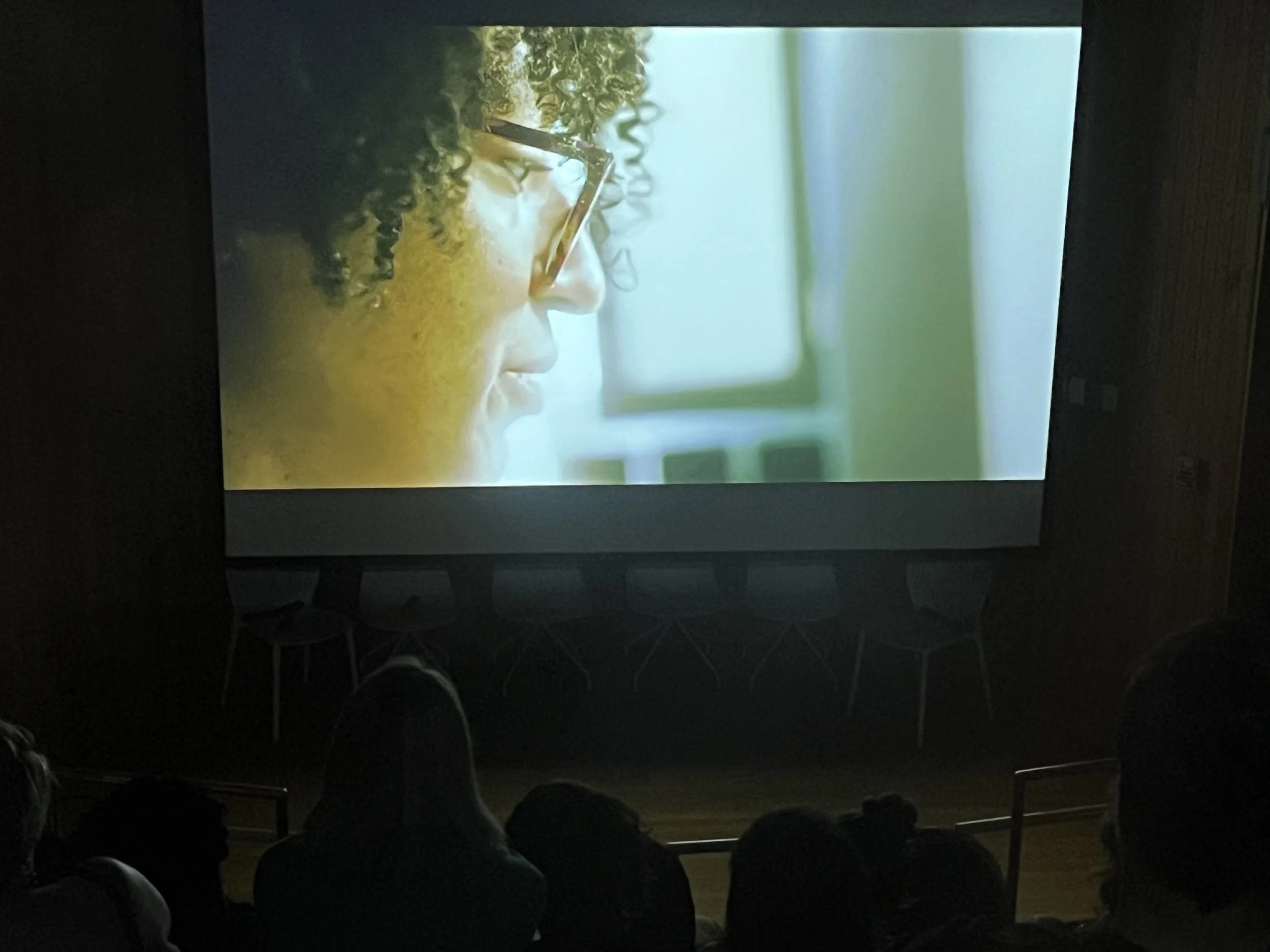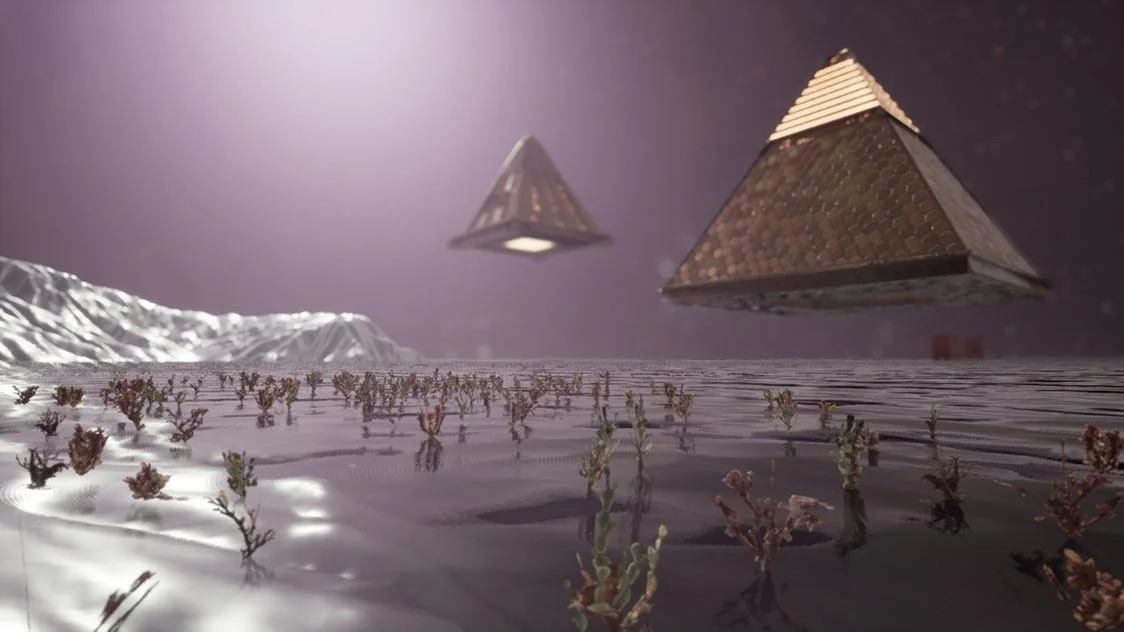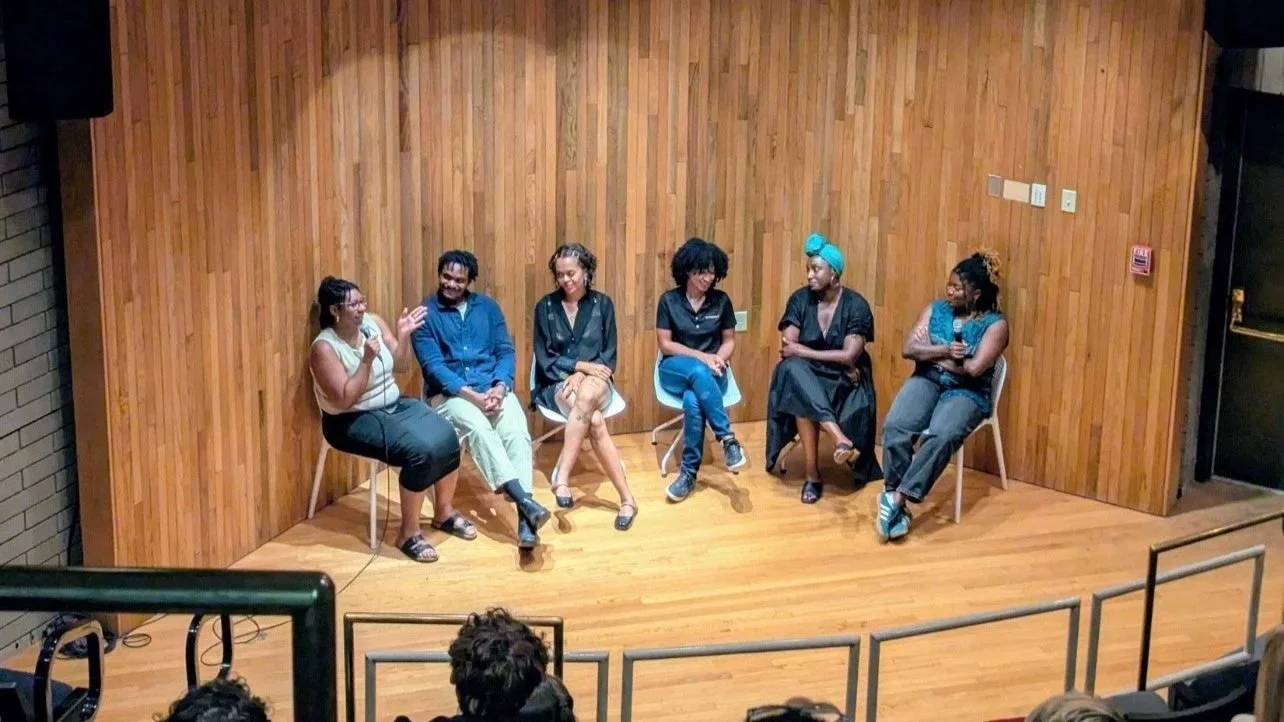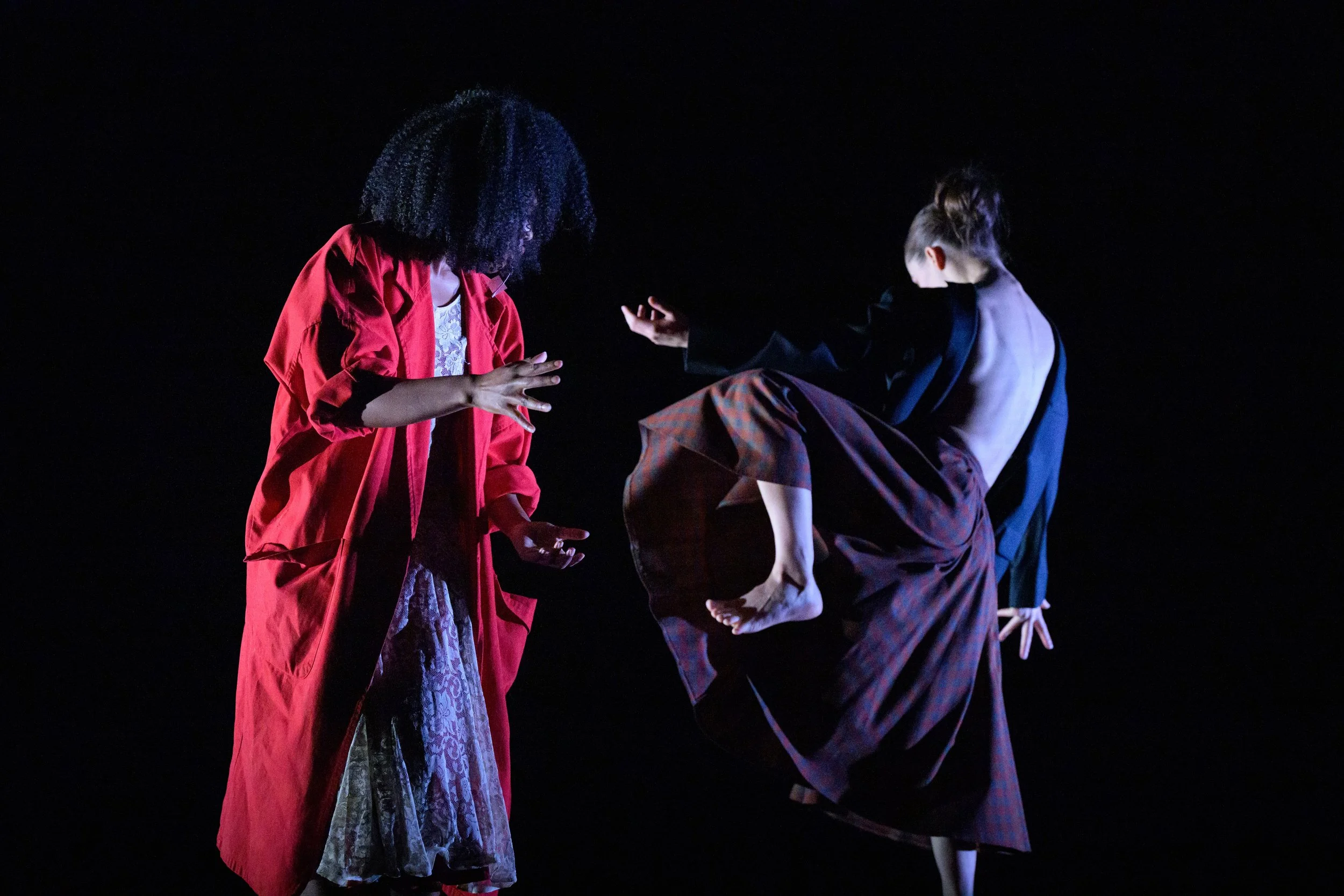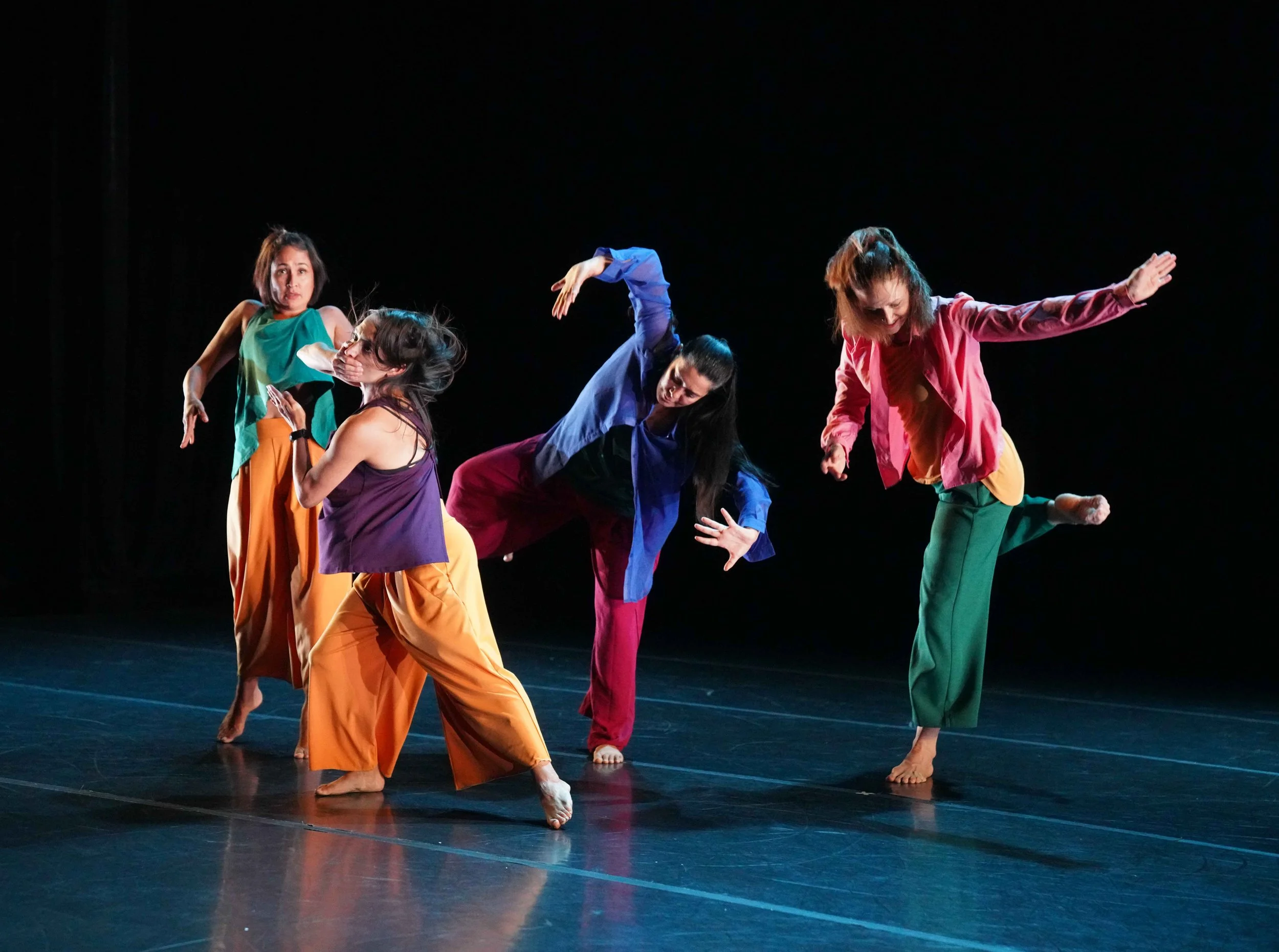On Friday, August 22nd, the seats of UMOCA’s auditorium filled up to witness an evening of dance films curated by Irishia Hubbard Romaine, a dancer-filmmaker who lived in Salt Lake City for 3 years. “Strands of Identity: Excerpt and Guest Artist Screening” presented five works exploring the Black experience in Utah through a variety of perspectives, genres, and methods.
Two of the films were created by Romaine: “F3VER” (2024), a documentary following the journey of Andrew “3D Dance Fever” Jones in his roles as street dancer, high school substance abuse counselor, and globally recognized dance fitness instructor; and “Strands of Identity”—Excerpt (2025), a nonfiction film following the experience of two Black women in Salt Lake City that use their hair as a symbol of resilience and connection. Irishia now lives in Pittsburgh, but returned to Salt Lake City for this evening of work, which was inspired by her time in Utah. “When I began developing Strands of Identity, I wanted to create a documentary that highlighted aspects of my experience during my time here in Salt Lake — the people, the stories, the movement, and the memories that stayed with me,” Romaine shared.
The other three films were curated by Romaine to share the spirit of resilience and creativity of Black filmmaking in a white-dominated field. These five films offered a dynamic evening that approached Black storytelling through a range of methods, including fantastical world building, through traditional documentary, through experimental non-fiction filmmaking, and through abstract screendance. Each of these methods centered the experience of Black artists through generative movement and authentic storytelling.
“Nobody’s Child”—Excerpt (2025), directed by Makayla Hopkins, is a documentary through the eyes of Makayla of her father, Charlie who was born during the Vietnam War to an American GI and Thai mother in Bangkok.
“Invisible Power” (2023), directed by Cayla Mae Simpson,is a screendance where two Black dancers move across the city of Newcastle seeking their own quiet moments.
“Gold Sphere” (2023), directed by Jade Charon Robertson, imagines gold hoop earrings becoming a portal to an alternate universe created by Black Girls who can study, research, and find connection through movement. This short film is rooted in Afrofuturism and envisions an universe where Black girls can discuss and escape the racial unrest in the United States of America.
After the screening, Aja Washington, Host and Lead Programmer of the Black, Bold, & Brilliant (BBB) series, facilitated a Q&A with several of the artists involved in creating the films. The Q&A cultivated a dynamic conversation about race, racism, and the very specific experience of being Black in Salt Lake City. Many of the panelists remarked on how rare it is to have this kind of conservation – frankness about being Black in Utah, and having Black hair in Utah – publicly. Hubbard Romaine wanted to recognize the significance of the vulnerability that poet Franque Bains and rock artist Pepper Rose shared throughout the process of creating “Strands of Identity.” As Rose reflected, “I don’t ever say this stuff out loud.” For their part, Bains and Rose reflected that art allows ideas to be shared that might otherwise feel like oversharing. The films and the discussion that followed provided an opportunity for Black artists to share their authentic experience in their own words, and be visible on their own terms.
Pictured left to right: Aja Washington, Justis Aderibigbe, Makayla Hopkins, Pepper Rose, Franque Bains, and Irishia Hubbard Romaine.
By the end of the Q&A, I was struck by the way that film as an art form demands community; every aspect of the process relies on collaboration. After this event, I had the opportunity to sit down with Romaine to discuss her filmmaking and curatorial process.
Rae Luebbert: What brought this event together, especially as you are no longer living in Salt Lake?
Irishia Hubbard Romaine: I always wanted to tell a story of my experience of Salt Lake City. Everywhere I went people had their own perception of how I got there and the labels and the stigmas of who I am as a Black person living in Utah. I wanted to create something that highlighted this community and what was possible. In doing that, it became a much larger thing and I realized I needed to share an excerpt of this work.
Rae Luebbert: “F3VER.” is such an amazing documentary. What were you considering as the director to capture these scenes with the movement that reflected both what Andrew “3D Dance Fever” Jones is doing and how this is impacting the community?
Irishia Hubbard Romaine: This film was commissioned by Dance Camera West. I originally wanted to create a dance film shot in many locations. Then looking at the footage and because of some technical difficulties with the DP that was provided for me, I realized that all of these [original] locations would not work. So, I needed Andrew to actually talk about these locations. Andrew is such a lively person. On the first day we met, he sat down with the little spider man box that is pictured in the film and it had all of his life in there; medals, passports, money from abroad, gifts, everything in this box. He sat with me for an hour, hour and half ready to tell me his story. Every time he mentioned something from the box, he would say “And that was on this street!” “And that was over there!” This gave me a ton of locations. You see some of the spaces that are used are community spaces true to Bakersville, CA [where the work was filmed]. All the students have their own stories and we were able to pay them for their contributions.
Working with the technical difficulties meant that I had to rely on found footage. Andrew had all of this footage saved from traveling and working with kids. This actually made the story more interesting because you could see his younger self, but it also made the film really difficult to edit.
Rae Luebbert: This evening had five films, two of them you directed and the other three were from other directors and filmmakers, which you curated. These films represented a variety of genres, but all centered Black voices and experiences and storytelling. What drew you to these three other films included in the evening?
Irishia Hubbard Romaine: Justis shared Makayla’s work with me. I fell in love with the trailer. In relation to “Stands of Identity,” [“Nobody’s Child”] showed these singular perspectives about things that everyone has experienced but then have their own ways of navigating. Mikaela’s documentary does a great job of sharing that. A Black female filmmaker in Salt Lake City in a white male-dominated space, it is important for her to have a platform as she builds her career in Salt Lake. I saw Jade’s work through “Dance Camera West” as a board member. It was important for me to share this film knowing that it is a perspective that isn’t commonly reflected in the dance film circuit. I wanted to give it a platform to reach a different audience so people can see how you can weave the narrative with dancing while also having this identity portion. [Jade] was able to take the perspectives of her students and the community that she has built and give them that opportunity to see themselves in their new world with this motion capture.
I am always inspired by Cayla’s work. She has done a lot of work in New York with well known contemporary dance artists. The rhythm of her edits and how she is able to create an emotional draw from seeing these two figures experiencing something. [The two dancers] have crossed paths before, spiritually and are experiencing different sensations separately. I really enjoyed that film and what she was able to create. Cayla’s film “Invisible Power” was commissioned by Serendipity Institute for Black Arts, a UK organization whose mission is to centre perspectives from the African and African Caribbean Diaspora, embedded as part of cultural experience for all .
Rae Luebbert: All of these films are quite stunning. In Cayla’s film there is a moment where the dancers are leaning into each other in the street and you can really feel their weight pressing into each other.
Irishia Hubbard Romaine: Yeah, and I love the pacing of it too! We get to experience one of the figures in the rain and it continues to build. You are waiting for the resolve and then boom, it cuts into this next concept.
Rae Luebbert: My next question is about your film “Strands of Identity.” Can you talk about your process to approach nonfiction filmmaking? Specifically the way you play with elements planning and some improvisation and maybe letting the narrative evolve or surprise you?
Irishia Hubbard Romaine: I think I treated it like choreography. This might have been a challenge for certain individuals. When I create live performance choreography, I make up choreography on the spot. I can have a full skeleton of a score of sorts, but at the end of the day, I go off of what is happening in that moment and react in the present. I think that is how this documentary was created. I had clear ideas of what I hoped [Franque and Pepper] would talk about. In honoring how I wanted to approach documentary filmmaking and entering from a choreographic approach, there was only so much that I could plan for. I had an idea of location and things I wanted to capture.
After making this film, I have reflected a lot on the element of communication in a documentary process. I realized I needed to check in more about how much they would be sharing as the documentary filmmaking process and intense durational process. Explicitly breaking down that your emotions may shift during the process as you're working in this vulnerable place. You talk about these things in a studio setting and in a syllabus with group agreements, expectations, tractile feedback, verbal feedback. If I do this process again, I have been thinking about how I would build this same framework and apply it to film setting so everyone feels supported. I loved that we had these relationships so people felt vulnerable enough to share because of our shared love for each other.
Rae Luebbert: There is movement and dance in “Strands of Identity” which is really striking to watch. My understanding is that the folks in the film have varying levels of experience in dance and are mainly not professional dancers. Can you talk about what that was like to bring them into this movement experience? Did you offer any coaching?
Irishia Hubbard Romaine: Most of us would take this House class every week with Chacho Valdez at the School of Dance. We were already dancing. We danced together. How do I get them to feel more comfortable dancing solo? I would give them a task and we would talk through it and then I would count them in. Sometimes it would take five or six times to make them feel comfortable. We started with gestures related to care and what that feels like. I would guide them through a score and let them make choices within that.
Rae Luebbert: I know that “Strands of Identity” was an excerpt. Is a longer work coming?
Irishia Hubbard Romaine: I would love to continue editing to get the work in a place where I feel comfortable to see if there is money and support to extend the film. There was a third story …but I don’t know if it will necessarily [fit], … and I am no longer in Salt Lake. I will not be re-entering into this work until next year [because of other projects].
Rae Luebbert: That leads right into my next question! What else are you working on?
Irishia Hubbard Romaine: I am a curator for “Dance on Camera” this year. I have so many films to watch! I am an artist in residence for the Louis Armstrong museum. I will be going through his archives and doing light filming. I will be able to be in his house and will do a live performance in October.
I did a residency earlier this year in Wilmington, North Carolina called Cucaloris. They have a VR and immersion residency and I got to work with VR for the first time and we will have an artist salon in November. And that’s it!
For more information about Irishia, please visit her website at https://www.irishiahubbardromaine.com/.
There are two more events in the Black, Bold, & Brilliant Series:
Bring Them Home tells the story of a small group of Blackfoot people and their mission to establish the first wild buffalo herd on their ancestral territory since the species’ near-excinction a century ago. This was presented on November 5 at 7:00pm at the Utah Film Center
Beyond the Mix showcases a diverse array of genres and influences, highlighting the global reach of contemporary music. Presented on December 10 at 7:00pm at the Utah Film Center


